Strategies to increase fuel efficiency and manage fuel costs
Discover how to reduce fuel costs when gas prices are high.
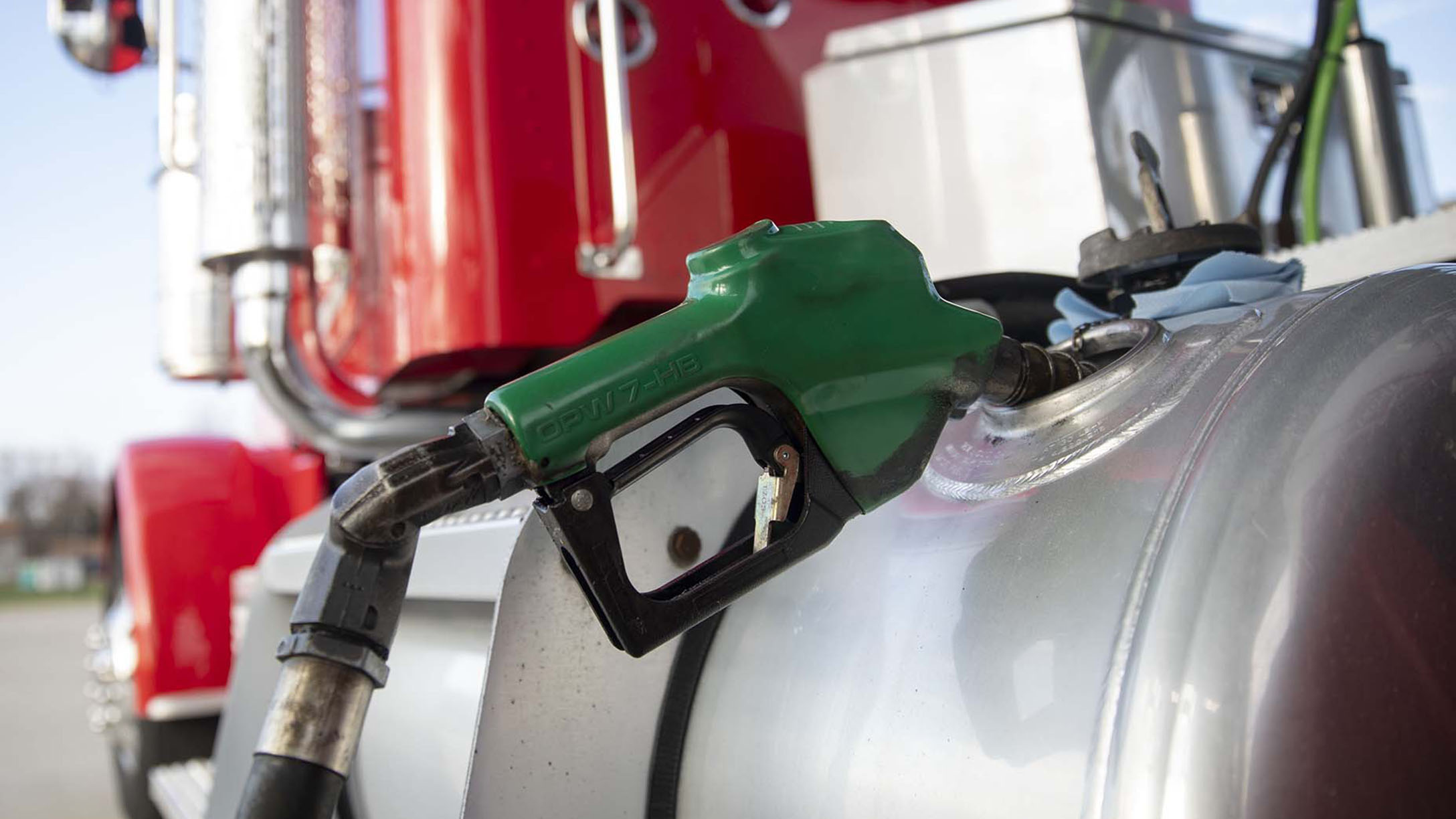
Fuel accounts for on average 60% of total fleet operating costs, so it's natural that controlling fuel consumption is a top priority for many companies. And with gas prices remaining high, managers are under even greater pressure to control fleet fuel costs while maintaining operations. Meanwhile, fleets are also coming under scrutiny to reduce their carbon emissions in order to help their organizations meet their climate targets.
The good news is that any strategy that reduces your fleet’s fuel consumption also reduces carbon emissions and makes it more sustainable. In this article, we investigate how to reduce gas costs and tailpipe CO2 emissions.
Fleet management strategies for improving fuel efficiency
To create a more a more fuel-efficient and environmentally-friendly fleet, consider implementing these fleet management strategies:
Compare fuel usage trends for bigger wins
When targeting fuel usage patterns, it pays to look at the bigger picture. Fleets should be asking:
- What are my fuel consumption and idling trends over the last three months?
- What are the trends on aggressive driving, speeding and idling?
Reviewing trend reports can help track patterns and identify anomalies or coaching opportunities, while cross-referencing different metrics provides greater insight and prevents your data from being separated into silos.
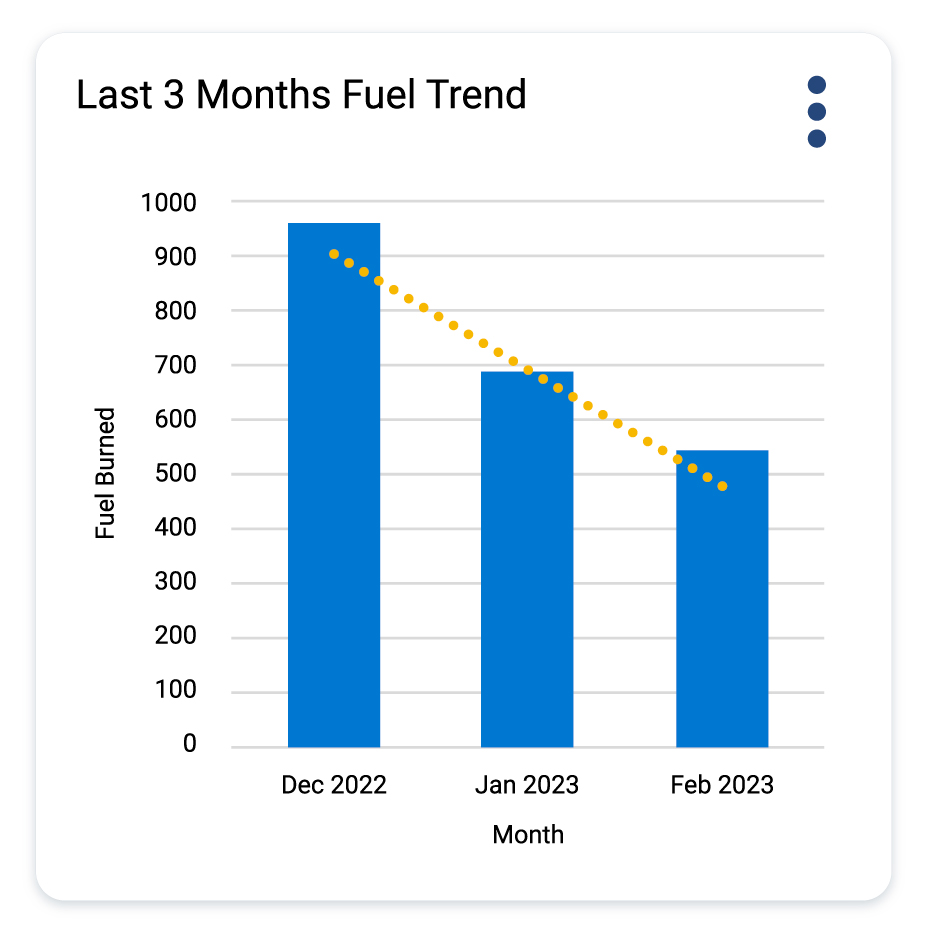
The Last 3 Months Fuel Trend report calculates fuel consumption from each vehicle's engine-based fuel efficiency data to help fleet monitor trends in fleetwide fuel consumption on a quarterly basis.
By watching these trend lines, fleets can tell whether their programs are working, or need fine-tuning. If you see fuel usage staying flat or increasing, it is an indicator that it’s time to review and adjust the program. Some of the key areas to monitor and manage are idling, driver behavior, and speeding.
Reduce unnecessary idling
Idling can use a quarter to a half gallon of fuel per hour and idling for just 30 seconds wastes more fuel than restarting the engine. As well as wasting fuel, idling leaves residues that damage engine components and cause higher maintenance costs over time. It also increases your fleet’s CO2 emissions, contributes to air pollution and impacts health and well-being in the community. Check out our idling article to learn more about how to control this wasteful behavior.
Control driver behavior
Did you know that aggressive driving can affect fuel economy by an average of 31%? Excessive speeding, rapid acceleration, harsh braking and cornering and tailgating are aggressive driving behaviors that also negatively affect a driver’s fuel efficiency. With the right training, you can provide your drivers with the tools they need to drive as cleanly and safely as possible. Read how Black & Veatch used a Driver Safety Scorecard to reduce the number of high-risk drivers by 87%, lowering collisions from 5 to 3 collisions per million mile.
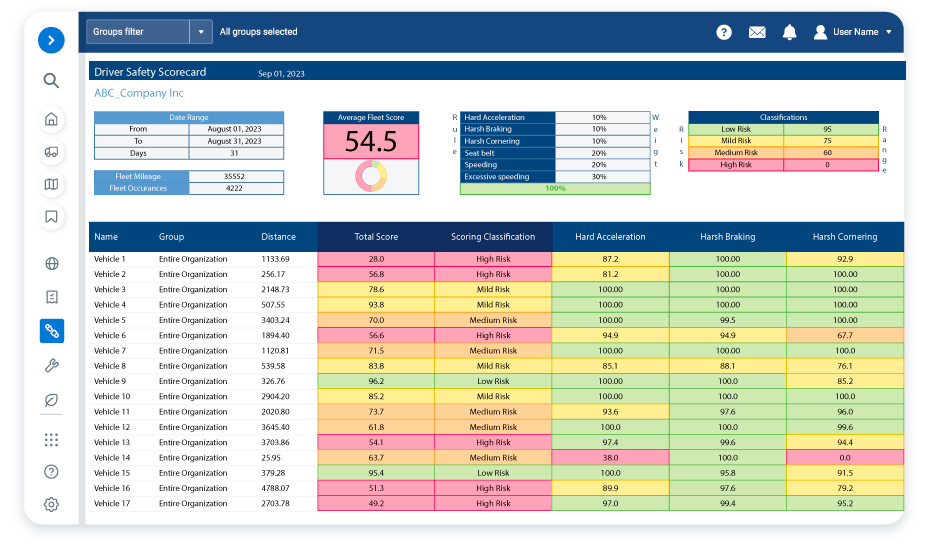
With the Driver Safety Scorecard Report, you can effectively evaluate drivers based on how efficiently they drive. Then you can gamify and motivate eco-driving behavior by sharing leaderboard results and setting up rewards for top performers to help motivate drivers to aim for those top spots.
Set speed restrictions
Reducing and restricting your fleet’s speed is another strategy for increasing fuel economy since driving at slower speeds requires less fuel. The U.S. Department of Energy calculates that each 5 mph your vehicles drive over 50 mph is like paying an additional $0.27 per gallon for gas.
Optimize your routes
Fuel savings can be achieved by evaluating whether drivers are taking the most efficient routes, or if the most efficiently placed drivers are being dispatched to service calls. This is a great example of where fuel and sustainability-related optimizations can also positively influence fleet productivity, creating the opportunity for more customer visits to be made per day.
Practice preventative maintenance
Engine malfunctions, faulty oxygen sensors and improperly inflated tires can all contribute to a drop in fuel efficiency. According to the United States Department of Energy, under-inflated tires can reduce fuel economy by as much as 3%. Monitoring vehicle health in real-time allows you to service vehicles before minor problems become larger and more expensive and before they have a chance to adversely impact your fleet’s fuel economy and environmental performance.
Rightsize vehicles to their tasks
Choosing the right vehicle for each task is critical to managing fuel. Using a large truck for a small load and short distance is inefficient and increases your fuel costs. Check out our rightsizing article to learn how to best perform this valuable exercise.
Lighten the load
The lighter the vehicle’s load, the more fuel-efficient it will be. Making sure that drivers are carrying only what they need as part of their cargo makes a big difference in fuel consumption. The EPA reports that every extra 100 pounds of weight on a vehicle can lower fuel economy by 1%, with roof cargo having the greatest impact.
Use fuel cards
One of the ways to improve fleet efficiency is through driver fuel cards. In addition to making fuel payment more convenient for drivers, a benefit of fuel cards is that they help fleet managers keep track of fuel purchases for greater transparency. You can use a fuel management system to manage your fleet’s fuel card usage.
Start investigating EVs
Electrification doesn’t need to happen overnight, but now is a good time to start evaluating EVs and consider where they might fit. In the right applications, they have a lower total cost of ownership. EVs are also more environmentally friendly and will play a key role in creating a more sustainable fleet.
Collect accurate data
In fleet management, the mantra “you can’t manage what you’re not measuring” is particularly relevant. Whatever strategies you plan to put in place to improve your fleet’s fuel-efficiency, you will need to be able to measure the results accurately and compare them against a baseline so that you can see their effect.
Important metrics include fuel consumption, miles driven, fuel spend, idling time and CO2 emissions. This is all information that your telematics solution should be able to provide, and data should be compared before and after strategies have been implemented. The more granular your data, the more valuable it will be to you, so ideally all data should be collected at a vehicle-level, with the ability to compare different time periods, drivers and routes.
Further improvement opportunities can be identified by benchmarking your fleet’s performance against that of fleets with similar duty cycles to your own. The process of tracking, reporting and benchmarking will enable you to more effectively employ fuel and emission reduction strategies, and to isolate the factors that contribute the most to excess fuel use, in order to manage the swiftest reduction of fleet emissions and fuel costs.
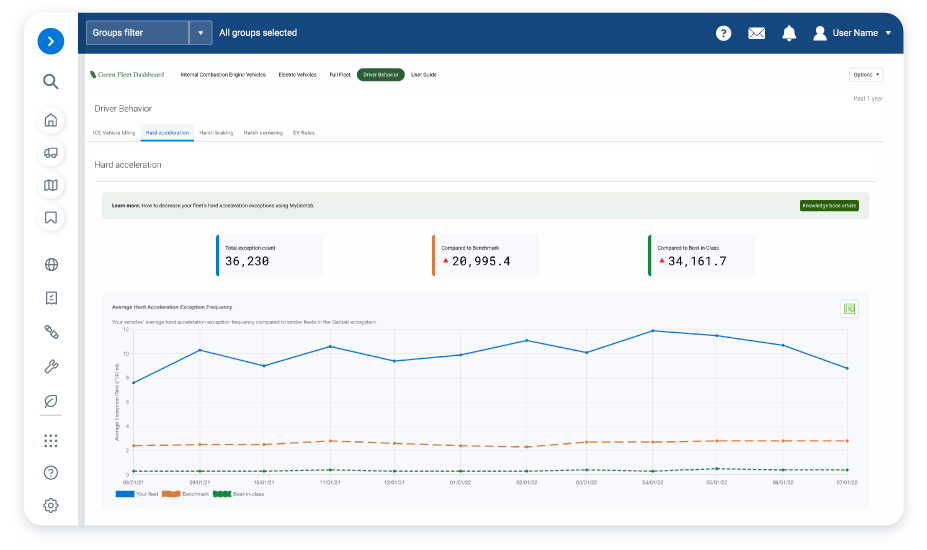
Geotab’s Green Fleet Dashboard provides metrics on fuel use, emissions, electric vehicle (EV) usage and driver behavior. In doing so, fleets gain insight into their cost and environmental performance over time, and can identify opportunities for improvement based on benchmarking with like fleets.
When attempting to make your fleet more sustainable and reduce fuel costs, the key is to not let yourself get overwhelmed by the big picture. Pick a couple of simpler strategies to start, measure the improvements that result from them, and use these successes to secure greater engagement and buy-in from your team. You’ll soon start to see the wider benefits that flow as a result, from lower fuel costs to reduced maintenance bills, improved vehicle health and greater service productivity.
For more guidance on how to leverage practices like these to curb fuel usage and support your sustainable fleet goals, check out our ebook Driving down emissions: The road to a more sustainable fleet today.
This article was originally published on March 10, 2022.
Subscribe to get industry tips and insights
The Geotab Team write about company news.
Table of Contents
Subscribe to get industry tips and insights
Related posts


How to avoid high downtime costs for construction fleets
March 10, 2025
2 minute read
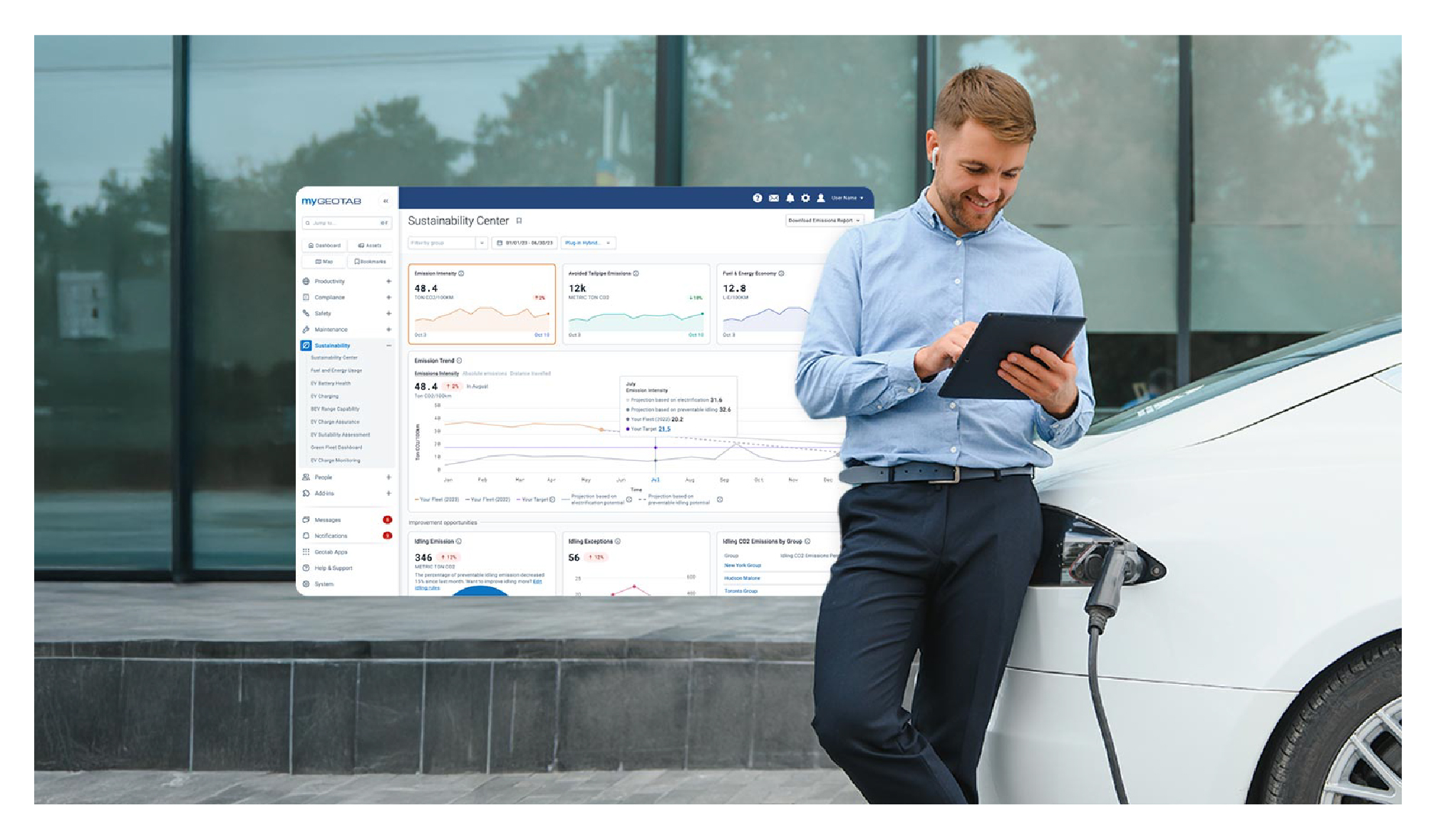
Geotab’s new fleet Sustainability Center simplifies fuel and emissions reduction
March 3, 2025
3 minute read

What Is Fleet Management? A Complete Guide for Fleet Managers
January 21, 2025
5 minute read

